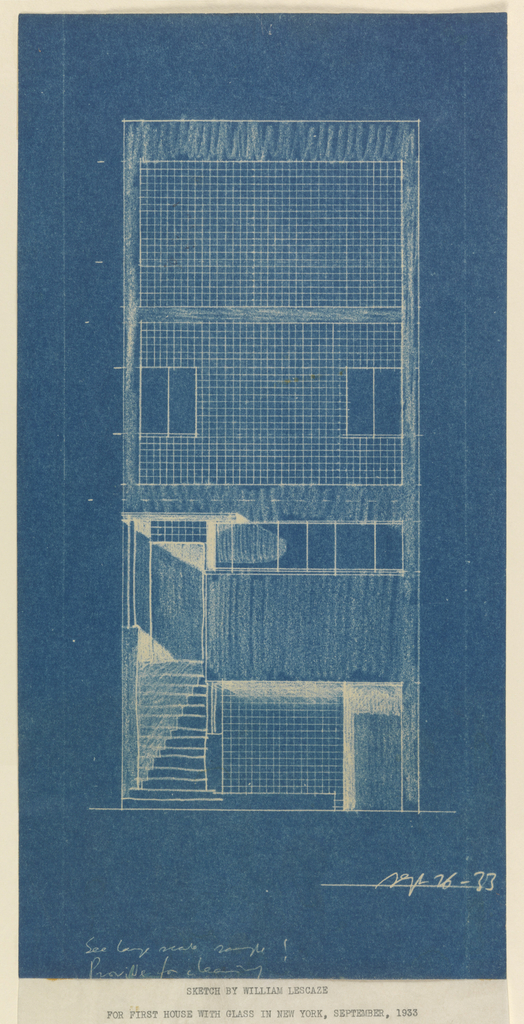This blueprint in the Cooper-Hewitt collection depicts architect William Lescaze’s radical and trendsetting four-story townhouse at 211 East 48th Street, New York. Little, if any, changes were made between this design—or between a sketch, also in the museum’s collection—and the final structure, built in 1933–34. Lescaze’s townhouse, which he used as his home and office, re-imagined the standard row house and introduced the first modernist-style townhouse in New York, and possibly in the US.
In the 1930s, and even today, most residential urban blocks were filled with highly ornamented nineteenth-century townhouses—single-family structures in a series of houses connected by a common side wall—of brownstone, brick, and limestone. Lescaze’s, instead, has a flat facade, large, horizontal windows of glass brick, and stucco walls. As a modernist architect, Lescaze did not believe in adding ornament to a building; he chose materials with function in mind, and any decorative effects created were simply happy accidents.
The Swiss-born designer followed European examples with the choice of glass bricks, seen on all four stories, but was one of the first architects in the US to use this material. A note, perhaps affixed to the blueprint by a curator in 1937 when the print was acquired, is telling: “Sketch by William Lescaze / for the first house with glass in New York, September, 1933.” He was making history, but history-making was not necessarily his goal: designing a functional residence was. The glass bricks allow light to enter the interior while retaining privacy and blocking an uninteresting view of a brownstone across the street. Anyone who has lived in a city knows plate-glass windows require blinds to avoid public observation or to avoid observing the public, which results in limited natural light. In this structure, Lescaze solved one of city residents’ constant annoyances.
Soon after the building’s construction and throughout the 1930s, glass bricks became a symbol of high-style modernism. The townhouse, which was named a landmark in 1976 and still stands today, inspired and influenced other architects to reinvent the nineteenth-century residence. The 1930s through 1950s saw the construction of at least seven other modernist-style structures without ornamentation, flat facades, and horizontal windows, and additionally, Lescaze was commissioned to design two similar structures for Upper East Side clients.
Today, architects continue to reinvent the townhouse, with varying degrees of acceptance from their neighbors or the design community. But when wandering around city streets and passing row houses with glass brick or horizontal windows, or even those that resemble nothing the city has ever seen before—Matthew Baird’s Greenwich Village Townhouse, for one—it is worth remembering Lescaze, who set the groundwork for reinventing the New York townhouse.

One thought on “William Lescaze’s Townhouse Blueprint: Creating a New Look for New York Residences”
Abiha on August 30, 2019 at 7:28 am
Lescaze’s, instead, has a flat facade, large, horizontal windows of glass brick, and stucco walls (ELZ Residence).